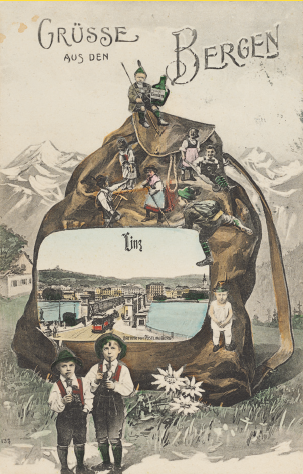Welcome at the Interface Culture program website.
Acting as creative artists and researchers, students learn how to advance the state of the art of current interface technologies and applications. Through interdisciplinary research and team work, they also develop new aspects of interface design including its cultural and social applications. The themes elaborated under the Master's programme in relation to interactive technologies include Interactive Environments, Interactive Art, Ubiquitous Computing, game design, VR and MR environments, Sound Art, Media Art, Web-Art, Software Art, HCI research and interaction design.

The Interface Culture program at the Linz University of Arts Department of Media was founded in 2004 by Christa Sommerer and Laurent Mignonneau. The program teaches students of human-machine interaction to develop innovative interfaces that harness new interface technologies at the confluence of art, research, application and design, and to investigate the cultural and social possibilities of implementing them.
The term "interface" is omnipresent nowadays. Basically, it describes an intersection or linkage between different computer systems that makes use of hardware components and software programs to enable the exchange and transmission of digital information via communications protocols.
However, an interface also describes the hook-up between human and machine, whereby the human qua user undertakes interaction as a means of operating and influencing the software and hardware components of a digital system. An interface thus enables human beings to communicate with digital technologies as well as to generate, receive and exchange data. Examples of interfaces in very widespread use are the mouse-keyboard interface and graphical user interfaces (i.e. desktop metaphors). In recent years, though, we have witnessed rapid developments in the direction of more intuitive and more seamless interface designs; the fields of research that have emerged include ubiquitous computing, intelligent environments, tangible user interfaces, auditory interfaces, VR-based and MR-based interaction, multi-modal interaction (camera-based interaction, voice-driven interaction, gesture-based interaction), robotic interfaces, natural interfaces and artistic and metaphoric interfaces.
Artists in the field of interactive art have been conducting research on human-machine interaction for a number of years now. By means of artistic, intuitive, conceptual, social and critical forms of interaction design, they have shown how digital processes can become essential elements of the artistic process.
Ars Electronica and in particular the Prix Ars Electronica's Interactive Art category launched in 1991 has had a powerful impact on this dialog and played an active role in promoting ongoing development in this field of research.
The Interface Cultures program is based upon this know-how. It is an artistic-scientific course of study to give budding media artists and media theoreticians solid training in creative and innovative interface design. Artistic design in these areas includes interactive art, netart, software art, robotic art, soundart, noiseart, games & storytelling and mobile art, as well as new hybrid fields like genetic art, bioart, spaceart and nanoart.
It is precisely this combination of technical know-how, interdisciplinary research and a creative artistic-scientific approach to a task that makes it possible to develop new, creative interfaces that engender progressive and innovative artistic-creative applications for media art, media design, media research and communication.
Linz auf Sommerfrische - Naherholung im Mühlviertel und Salzkammergut
Eröffnung: 7.5.2024, 19.00 Uhr, Ausstellung bis 25.8.2024 Nordico Stadtmuseum, Linz Simon-Wiesenthal-Platz 1, 4020 Linz
mit u.a. Chris Althaler, Norbert Artner, Katharina Brandl, Margit Feyerer- Fleischanderl, Gregor Graf, Ursula Guttmann, Johann Hazod, Gerlinde Miesenböck,Violetta Wakolbinger, Bibiana Weber
Begrüßung: Andrea Bina, Kuratorin, Leiterin Nordico Stadtmuseum
Einführung: Michaela Nagl, Kuratorin
Eröffnung: Doris Lang-Mayerhofer, Kulturstadträtin der Stadt Linz
Die Reise in die Sommerfrische führt von Linz aus ins nahe gelegene Mühlviertel und ins Salzkammergut. Zwei unterschiedliche Regionen, die sich ideal für einen Aufenthalt „in der Frisch“ eignen. Abhängig von den jeweiligen Fortbewegungsmitteln (Kutsche, Pferdeeisenbahn, Eisenbahn, Schiff, Auto) kann das Erholungsgebiet gemächlich oder schnell erreicht werden. Auch die Aufenthaltsdauer variiert zwischen mehreren Wochen, wie aus lebhaften Beschreibungen zu erfahren ist, oder einigen Tagen. Ziel ist es, der Hitze der Stadt zu entfliehen und sich den Reizen der Landschaft hinzugeben. Ob im hügeligen, waldreichen Mühlviertel mit Heilquellen und Burgruinen oder im seenreichen, gebirgigen Salzkammergut mit nostalgischer Vergangenheit. Beide Regionen erfüllen die Sehnsucht nach Erholung.
Mittels Bildmaterial und Kunstwerken, die größtenteils aus den Sammlungen des Nordico Stadtmuseum und Lentos Kunstmuseum stammen, sowie historischen und aktuellen Video und Audioaufnahmen, thematisiert die Ausstellung das Phänomen Sommerfrische in seinen unterschiedlichsten Facetten.
Ergänzt wird sie um zeitgenössische Positionen, die sich aus der Kooperation zwischen Kunstuniversität Linz und Alpenverein Linz, der heuer sein 150-Jahr-Jubiläum feiert, entwickelten.
Kuratorinnen: Andrea Bina, Michaela Nagl, Lisa Schmidt
Ausstellungsarchitektur: Thomas Pauli
Mit Werken von:
Franz Josef Altenburg, Chris Althaler, Norbert Artner, Christian Ludwig Attersee, Herbert Bayer, Heinz Bitzan, Carl Blumauer, Heinrich Böhler, Eva Bosch, Katharina Brandl, Dietmar Brehm, Klemens Brosch, Helene Clodi-Titze, Gunter Damisch, Inge Dick, Albrecht Dunzendorfer, Thomas Ender, Lisl Engels, Margit Feyerer- Fleischanderl, Melchior Fritsch, Fritz Fröhlich, Bernhard Fuchs, Gregor Graf, Hugo Grienberger, Ursula Guttmann, Ludwig Haase, Nicola Hackl-Haslinger, Josef Hafner, Elli Haidinger-Fürböck, Otto Hainzl, Hauenschild/Ritter, Karl Hauk, Karl Hayd, Johann Hazod, Egon Hofmann-Linz, Edgar Honetschläger, Bernadette Huber, Gustav Klimt, Hanns Kobinger, Sophie Koko, Auguste Kronheim, Peter Kubovsky, Maria Lassnig, Andrea Lehmann, Daniel Leidenfrost, Anton Lutz, Matthias May, Oswald Miedl, Doris Miedl-Pisecky, Gerlinde Miesenböck, Hans Gösta Nagl, François de Naumann, Michael Neumüller, Kurt Ohnsorg, Stefan Olàh, Margit Palme, Thomas Pauli, Hans Pollack, Johann Razinger, Rudolf Němec, Rosa Scherer, Max Schlager, Emilie Schleiss- Simandl, Josef Schnetzer, Julius Schnorr von Carolsfeld, Agathe Schwabenau, Antonie Schwabenau, Renate Schwarzer, Julius Seidel, Isa Stein, Thomas Stimm, Ingeborg Strobl, Inge Thaller, Gerhard Trumler, Eduard Uhlik, Violetta Wakolbinger, Bibiana Weber, Hans Wöhrl, Franz Zülow
Studierende der Kunstuniversität Linz (Abteilung Künstlerische Wissenspraktiken Lehrbeauftragte Gudrun Wallenböck) im Rahmen der Kooperation mit dem Alpenverein Linz (i. V. Gottfried Seisenbacher) zu seinem 150-jährigen Jubiläum: Polina Afanasyeva, Carlotta Zoe Borcherding, Robert Hinta, Julia Höglinger, Andrea Hörndler / Hannes Wizany, Mario Moder, Maximilian Niederer, Dana Patsch
www.nordico.at/ausstellungen/linz-auf-sommerfrische
